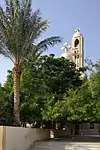Saint Catherine's Monastery
Saint Catherine's Monastery (Arabic: دير القدّيسة كاترين; Greek: Μονὴ τῆς Ἁγίας Αἰκατερίνης), officially the Sacred Autonomous Royal Monastery of Saint Katherine of the Holy and God-Trodden Mount Sinai,[upper-alpha 1] is an Eastern Orthodox monastery located on the Sinai Peninsula. It lies at the mouth of a gorge at the foot of Mount Sinai, near the town of Saint Catherine, in Egypt. The monastery is named after Catherine of Alexandria.[1][2]
 The monastery with Willow Peak (traditionally considered Mount Horeb) in the background | |
| Monastery information | |
|---|---|
| Order | Church of Sinai |
| Denomination | Eastern Orthodox Church |
| Established | AD 565 |
| People | |
| Founder(s) | Justinian I |
| Site | |
| Location | Saint Catherine, South Sinai Governorate, Egypt |
| Coordinates | 28°33′20″N 33°58′34″E |
| Website | www |
| Official name | Saint Catherine Area |
| Type | Cultural |
| Criteria | i, iii, iv, vi |
| Designated | 2002 (26th session) |
| Reference no. | 954 |
| Region | Arab States |
Controlled by the autonomous Church of Sinai, which is part of the wider Greek Orthodox Church, the monastery became a UNESCO World Heritage Site in 2002 for its unique importance in the traditions of Christianity, Islam, and Judaism.[3][4] Saint Catherine's has as its backdrop the three mountains it lies near: Ras Sufsafeh (possibly the Biblical Mount Horeb, peak c.1 km (0.62 mi) west); Jebel Arrenziyeb, peak c. 1km south; and Mount Sinai (locally, Jebel Musa, by tradition identified with the biblical Mount Sinai; peak c. 2 km (1.2 mi) south).[5]
Built between 548 and 565, it is the oldest continuously inhabited Christian monastery in the world.[6][7][8] The site also holds the world's oldest continually operating library,[9] with unique or extremely rare works, such as the Codex Sinaiticus and the Syriac Sinaiticus,[10][9] as well as possibly the largest collection of early Christian icons, including the earliest known depiction of Jesus as Christ Pantocrator.
Christian traditions
During Catherine's imprisonment more than 200 people came to see her, including Maxentius' wife, Valeria Maximilla; all converted to Christianity and were subsequently martyred.[11] The furious emperor condemned Catherine to death on a spiked breaking wheel, but, at her touch, it shattered.[12] Maxentius ordered her to be beheaded. Catherine herself ordered the execution to commence. And also according to legend, a milk-like substance rather than blood flowed from her neck.[13]
The monastery was built around the location of what is traditionally considered to be the place of the burning bush seen by Moses.[2] Although it is commonly known as Saint Catherine's, the monastery's official name is the Sacred Autonomous Royal Monastery of Saint Katherine of the Holy and God-Trodden Mount Sinai.[14] The patronal feast of the monastery is the Feast of the Transfiguration. It has become a favorite site of pilgrimage.[2]
History
_p057_MT._SINAI_OR_JEBEL_MUSA.jpg.webp)
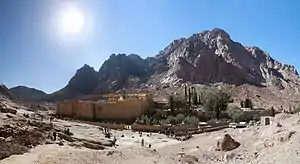
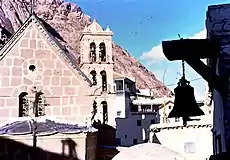
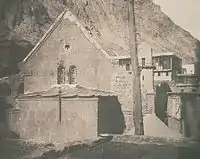
The oldest record of monastic life at Mount Sinai comes from the travel journal written in Latin by a pilgrim woman named Egeria (Etheria; St Sylvia of Aquitaine) about 381/2–386.[15][16]
The monastery was built by order of Emperor Justinian I (reigned 527–565), enclosing the Chapel of the Burning Bush (also known as "Saint Helen's Chapel") ordered to be built by Empress Consort Helena, mother of Constantine the Great, at the site where Moses is supposed to have seen the burning bush.[17] The living bush on the grounds is purportedly the one seen by Moses.[18] Structurally the monastery's king post truss is the oldest known surviving roof truss in the world.[19] The site is sacred to Christianity, Islam, and Judaism.[20]
A mosque was created by converting an existing chapel during the Fatimid Caliphate (909–1171), which was in regular use until the era of the Mamluk Sultanate in the 13th century and is still in use today on special occasions. During the Ottoman Empire, the mosque was in desolate condition; it was restored in the early 20th century.[21]
During the seventh century, the isolated Christian anchorites of the Sinai were eliminated: only the fortified monastery remained. The monastery is still surrounded by the massive fortifications that have preserved it. Until the twentieth century, access was through a door high in the outer walls. From the time of the First Crusade, the presence of Crusaders in the Sinai until 1270 spurred the interest of European Christians and increased the number of intrepid pilgrims who visited the monastery. The monastery was supported by its dependencies in Egypt, Palestine, Syria, Crete, Cyprus and Constantinople.
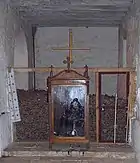
The monastery, along with several dependencies in the area, constitute the entire Church of Sinai, which is headed by an archbishop, who is also the abbot of the monastery. The exact administrative status of the church within the Eastern Orthodox Church is ambiguous: by some, including the church itself,[22] it is considered autocephalous,[23][24] by others an autonomous church under the jurisdiction of the Greek Orthodox Church of Jerusalem.[25] The archbishop is traditionally consecrated by the Greek Orthodox Patriarch of Jerusalem; in recent centuries he has usually resided in Cairo. During the period of the Crusades which was marked by bitterness between the Orthodox and Catholic churches, the monastery was patronized by both the Byzantine emperors and the rulers of the Kingdom of Jerusalem, and their respective courts.
On April 18, 2017, an attack by the Islamic State group at a checkpoint near the Monastery killed one policeman and injured three police officers.[26]
Manuscripts and icons
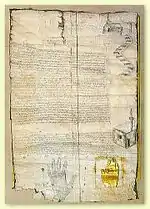
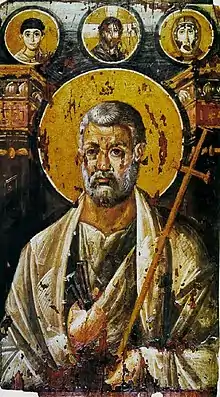
The library, founded sometime between 548 and 565, is the oldest continuously operating library in the world.[27] The monastery library preserves the second largest collection of early codices and manuscripts in the world, outnumbered only by the Vatican Library.[28] It contains Greek, Christian Palestinian Aramaic, Syriac, Georgian, Arabic, Ethiopic/Ge‘ez, Latin, Armenian, Church Slavonic, and Caucasian Albanian[29] manuscripts and books, and very rare Hebrew Language,[30] some Coptic books.[9]
In May 1844 and February 1859, Constantin von Tischendorf visited the monastery for research and discovered the Codex Sinaiticus, dating from the 4th century, at the time the oldest almost completely preserved manuscript of the Bible. The finding from 1859 left the monastery for Russia, in circumstances that had been long disputed. But in 2003 Russian scholars discovered the donation act for the manuscript signed by the Council of Cairo Metochion and Archbishop Callistratus on 13 November 1869. The monastery received 9000 rubles as a gift from Tsar Alexander II of Russia.[31] The Codex was sold by Stalin in 1933 to the British Museum and is now in the British Library, London, where it is on public display. Prior to September 1, 2009, a previously unseen fragment of Codex Sinaiticus was discovered in the monastery's library,[32][33] as well as among the New Finds of 1975.[34][9] On other visits (1855, 1857) Constantin von Tischendorf also amassed there more valuable manuscripts (Greek, Christian Palestinian Aramaic, Georgian, Syriac) and took them with him to St Petersburg and Leipzig, where they are stored today.[35][36][37][38][39][40][41]
In February 1892, Agnes S. Lewis discovered an early palimpsest manuscript of the Gospel in St Catherine Monastery's library that became known as the Syriac Sinaiticus and is still in the monastery's possession.[42] Agnes and her sister Margaret D. Gibson returned in 1893 with the Cambridge team of the two scholars that included their wives, and also J. Rendel Harris to photograph and transcribe the manuscript in its entirety, as well as to prepare the first catalogues of the Syriac and Arabic manuscripts.[43][44][45] Only among the New Finds two additional palimpsest manuscripts came to light containing additional passages of the Old Syriac Gosples.[46]
| External video | |
|---|---|
The Monastery also has a copy of the Ashtiname of Muhammad, in which the Islamic prophet Muhammad is claimed to have bestowed his protection upon the monastery.[47]
Additionally, the monastery houses a copy of Mok'c'evay K'art'lisay, a collection of supplementary books of the Kartlis Cxovreba, dating from the 9th century.[48]
The most important manuscripts have since been filmed or digitized, and so are accessible to scholars. With planning assistance from Ligatus, a research center of the University of the Arts London, the library was extensively renovated, reopening at the end of 2017.[49][50][9]
Sinai Palimpsests Project
Since 2011, a team of imaging scientists[51][9] and experienced scholars in the decipherment of palimpsest manuscripts [52][9] from the U.S. and Europe have photographed, digitized, and studied the library's collection of palimpsests during the international Sinai palimpsests project.[53][9][17][54]
Palimpsests are notable for having been reused one or more times over the centuries. Since parchment was expensive and time-consuming to produce, monks would erase certain texts with orange juice or scrape them off and write over them.[55][9] Though the original texts were once assumed to be lost,[56] the imaging scientists used narrowband multispectral imaging techniques and technologies to reveal features that were difficult to see with the human eye, including ink residues and small grooves in the parchment.[17][28] Each page took approximately eight minutes to scan completely.[28] These images have subsequently been digitized and are now freely available for research at the UCLA Online Library for scholarly use.[9]
As of June 2018, at least more than 160 palimpsests were identified, with over 6,800 pages of texts recovered.[9] The newer finds were discovered in a secluded storage area of the St George Tower in 1975.[57][58][59][60][61][62] Highlights include "108 pages of previously unknown Greek poems and the oldest-known recipe attributed to the Greek physician Hippocrates;" additional folios for the transmission of the Old Syriac Gospels;[46] two unattested witnesses of an early Christian apocryphal text the Dormition of Mary (Transitus Mariae) of which most of the Greek text is lost;[63] a previously unknown martyrdom of Patriklos of Caesarea Maritima (Palestine), one of the eleven followers of Pamphilus of Caesarea; as well as insight into dead languages such as the previously hardly attested Caucasian Albanian[64][65] and Christian Palestinian Aramaic, the local dialect of the early Byzantine period, with many unparalleled text witnesses.[9]
Works of art
The complex houses irreplaceable works of art: mosaics, the best collection of early icons in the world, many in encaustic, as well as liturgical objects, chalices and reliquaries, and church buildings. The large icon collection begins with a few dating to the 5th (possibly) and 6th centuries, which are unique survivals; the monastery having been untouched by Byzantine iconoclasm, and never sacked. The oldest icon on an Old Testament theme is also preserved there. A project to catalogue the collections has been ongoing since the 1960s. The monastery was an important centre for the development of the hybrid style of Crusader art, and still retains over 120 icons created in the style, by far the largest collection in existence. Many were evidently created by Latins, probably monks, based in or around the monastery in the 13th century.[66]
Icons
 Icon of the enthroned Virgin and Child with saints and angels, 6th century
Icon of the enthroned Virgin and Child with saints and angels, 6th century The oldest known icon of Christ Pantocrator, encaustic on panel
The oldest known icon of Christ Pantocrator, encaustic on panel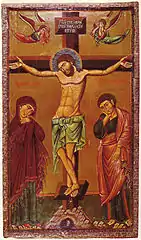 Crucifixion, 13th century
Crucifixion, 13th century Holy doors
Holy doors Madonna and Child, 13th century
Madonna and Child, 13th century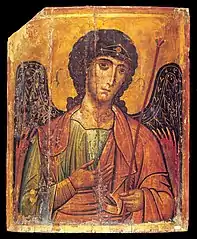 13th century Byzantine icon of Saint Michael the Archangel
13th century Byzantine icon of Saint Michael the Archangel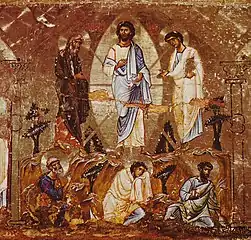 Transfiguration, 12th century
Transfiguration, 12th century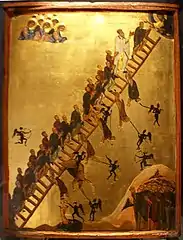 Ladder of Divine Ascent
Ladder of Divine Ascent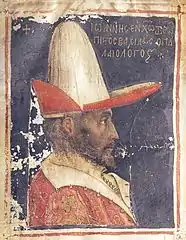 Emperor John VIII Palaiologos
Emperor John VIII Palaiologos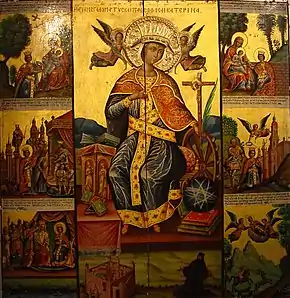 Icon of Saint Catherine of Alexandria
Icon of Saint Catherine of Alexandria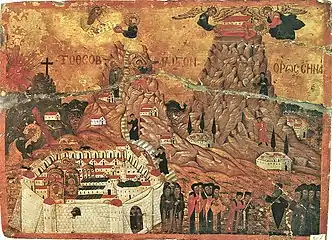 The monastery, 18th century
The monastery, 18th century.jpg.webp) Christ as the Ancient of Days, 7th century
Christ as the Ancient of Days, 7th century
Historical images
 Carsten Niebuhr (1762)
Carsten Niebuhr (1762).jpeg.webp) Description de l'Égypte (1809)
Description de l'Égypte (1809)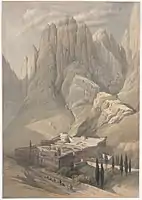 David Roberts, 1839, published in The Holy Land, Syria, Idumea, Arabia, Egypt, and Nubia
David Roberts, 1839, published in The Holy Land, Syria, Idumea, Arabia, Egypt, and Nubia_b_060.jpg.webp) Ernst Keil (1861)
Ernst Keil (1861)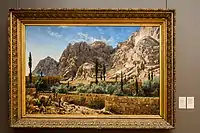 Adolf Meckel von Hemsbach (1892)
Adolf Meckel von Hemsbach (1892)
See also
- Archbishop of Mount Sinai and Raithu
- Ashtiname of Muhammad
- Caucasian Albanian script
- Charnel House
- Codex Climaci Rescriptus
- Codex Sinaiticus
- Codex Sinaiticus Rescriptus
- Cyril of Jerusalem
- Desert fathers
- Gregory of Sinai
- John Climacus
- Ladder of Divine Ascent
- Oldest churches in the world
- Martyrs of Palestine
- Poustinia
- Sinaites in Serbia
- Syriac Sinaiticus
- Transitus Mariae
Explanatory notes
- The monastery's full title in Greek: Ιερά Αυτόνομος Βασιλική Μονή Αγίας Αικατερίνης του Αγίου και Θεοβαδίστου Όρους Σινά
References
- Evans, Helen C. (2004). Saint Catherine's Monastery, Sinai, Egypt: A Photographic Essay. Metropolitan Museum of Art. ISBN 978-1-58839-109-4.
- "Saint Catherine's Monastery". Encyclopedia Britannica. July 1998. Retrieved 23 January 2021.
- Georgiou, Aristos (December 20, 2017). "These spectacular ancient texts were lost for centuries, and now they can be viewed online". International Business Times. Archived from the original on July 2, 2018.
- "Saint Catherine Area". UNESCO World Heritage Centre. United Nations Educational, Scientific, and Cultural Organization. Retrieved 7 September 2021.
- "Visit Saint Catherine Monastery, Egypt". visitafrica.site. Retrieved 2020-09-25.
- Din, Mursi Saad El et al.. Sinai: The Site & The History: Essays. New York: New York University Press, 1998. 80. ISBN 0814722032
- Jules Leroy; Peter Collin (2004). Monks and Monasteries of the Near East. Gorgias Press. pp. 93–94. ISBN 978-1-59333-276-1.
- "St Catherine Monastery - The Oldest in the World". KEEP CALM and WANDER. 2016-05-24. Retrieved 2022-04-21.
- "Sinai Palimpsests project". sinai.library.ucla.edu.
- Sebastian P. Brock, Two Hitherto Unattested Passages of the Old Syriac Gospels in Palimpsests from St Catherie’s Monastery, Sinai, Δελτίο Βιβλικῶν Μελετῶν 31A, 2016, pp. 7–18.
- "Saint Catherine of Alexandria". Encyclopedia Britannica. Encyclopædia Britannica. March 2017 [First published July 1998].
- Clugnet 1908.
- Morton 1841, p. 133.
- "Home". www.sinaimonastery.com. Retrieved 2021-09-05.
- John Wilkinson (2015), Egeria’s travels (Oxford: Oxbow Books). ISBN 978-0-85668-710-5
- Pilgrimage of Etheria text at ccel.org
- Schrope, Mark (September 6, 2012). "In the Sinai, a global team is revolutionizing the preservation of ancient manuscripts". The Washington Post. ISSN 0190-8286. Retrieved July 2, 2018.
- "Is the Burning Bush Still Burning?". Friends of Mount Sinai Monastery. Retrieved July 2, 2018.
- Feilden, Bernard M.. Conservation of historic buildings. 3rd ed. Oxford: Architectural Press, 2003. 51. ISBN 0750658630
- "The Monastery". St-Katherine-net. Retrieved 23 October 2014.
- "Saint Catherine Area".
- The official Website describes the Church as "διοικητικά "αδούλωτος, ασύδοτος, ακαταπάτητος, πάντη και παντός ελευθέρα, αυτοκέφαλος" or "administratively 'free, loose, untresspassable, free from anyone at any time, autocephalous'" (see link below)
- Weitzmann, Kurt, in: Galey, John; Sinai and the Monastery of St. Catherine, p. 14, Doubleday, New York (1980) ISBN 0-385-17110-2
- Ware, Kallistos (Timothy) (1964). "Part I: History". The Orthodox Church. Penguin Books. Retrieved 2007-07-14. Under Introduction Bishop Kallistos says that Sinai is "autocephalous"; under The twentieth century, Greeks and Arabs he states that "There is some disagreement about whether the monastery should be termed an 'autocephalous' or merely an 'autonomous' Church."
- The Orthodox Church of Mount Sinai CNEWA Canada, "A papal agency for humanitarian and pastoral support" Archived May 30, 2010, at the Wayback Machine
- "Deadly attack near Egypt's old monastery". BBC News. April 19, 2017. Retrieved July 2, 2018.
- Esparza, Daniel (19 August 2019). "The library of St. Catherine at Mount Sinai has never closed its doors". Retrieved 11 August 2020.
- Macdonald, Fleur (June 13, 2018). "Hidden writing in ancient manuscripts". BBC News. Archived from the original on July 2, 2018.
- Jost Gippert, The Creation of the Caucasian Alphabets as Phenomenon of Cultural History, in Referate des Internationalen Symposiums (Wien, 1.-4. Dezember 2005), ed. by Werner Seibt, Johannes Preiser-Kapeller, pp. 39-50, Wien: Verlag der Österreichischen Akademie der Wissenschaften 2011.
- Bo Isaksson, "The Monastery of St. Catherine and the New Finds," in Built on Solid Rock: Studies in Honour of Professor Ebbe Egede Knudsen on the Occasion of his 65th Birthday April 11th 1997, edited by Elie Wardini, pp. 128–140, Oslo: Novus forlag, 1997.
- The History of the acquisition of the Sinai Bible by the Russian Government in the context of recent findings in Russian archives (english Internetedition). The article from A.V. Zakharova was first published in Montfaucon. Études de paléographie, de codicologie et de diplomatique, Moscow–St.Petersburg, 2007, pp. 209–66) see also Alexander Schick, Tischendorf und die älteste Bibel der Welt. Die Entdeckung des Codex Sinaiticus im Katharinenkloster (Tischendorf and the oldest Bible in the world – The discovery of the Codex Sinaiticus in St. Catherine's Monastery), Muldenhammer 2015, pp. 123–28, 145–55.
- "Fragment from world's oldest Bible found hidden in Egyptian monastery". The Independent, 2 Sept, 2009,
- "Oldest known Bible to go online". BBC News, 3 August 2005.
- David C. Parker (2010), CODEX SINAITICUS: The Story of the World’s Oldest Bible. London. British Library, p. 18. ISBN 9780712358033
- M. F. Brosset (1858), Note sur un manuscrit géorgien de la Bibliothèque Impériale publique et provenant de M. Tischendorf, Mélanges Asiatiques 3, pp. 264-280.
- N. Pigoulewsky (1934), Fragments syro-palestiniens des Psaumes CXXIII-IV, Revue Biblique 43, pp. 519–527.
- N. Pigoulewski (1937), Manuscrits syriaques bibliques de Léningrad, Revue Biblique 46, pp. 83–92; N. Pigoulewski, Manuscrits syriaques bibliques de Léningrad (suite), Revue Biblique 46, 1937, pp. 225–230; 556–562.
- Julius Assfalg (1963), Georgische Handschriften (= Verzeichnis der orientalischen Handschriften in Deutschland, III) (Wiesbaden); Julius Assfalg (1965), Syrische Handschriften (= Verzeichnis der orientalischen Handschriften in Deutschland, V) (Wiesbaden).
- Sebastian P. Brock (2012), Sinai: a Meeting Point of Georgian with Syriac and Christian Palestinian Aramaic, in The Caucasus between East & West (Tbilisi), pp. 482–494.
- Grigory Kessel (2016), Membra Disjecta Sinaitica I: A Reconstitution of the Syriac Galen Palimpsest, in André Binggili et al. (eds.), Manuscripta Graeca et Orientalia: Mélanges monastiques et patristiques en l’honneur de Paul Géhin (Louvain: Peeters), pp. 469–498.
- Paul Géhin (2017), Les manuscrits syriaques de parchemin du Sinaï et leur membra disjecta, CSCO 665 / Subsidia 136 (Louvain: Peeters).
- The text was deciphered by Francis C Burkitt and Robert L. Bensly, see Gibson, Margaret Dunlop (1893). How the Codex was Found. Cambridge: Macmillan & Bowes. pp. 36–38.
- Gibson, Margaret Dunlop (1893). How the Codex was Found. Cambridge: Macmillan & Bowes. pp. 60–67.
- Agnes Smith Lewis (1894), Catalogue of the Syriac MSS. in the Convent of S. Catharine on Mount Sinai, Studia Sinaitica, I (London: C. J. Clay and Sons).
- Margaret Dunlop Gibson (1894), Catalogue of the Arabic mss. in the Convent of Saint Catharine on Mount Sinai. Studia Sinaitica, III (London: C. J. Clay and Sons).
- Sebastian P. Brock, Two Hitherto Unattested Passages of the Old Syriac Gospels in Palimpsests from St Catherine’s Monastery, Sinai, Δελτίο βιβλικῶν Μελετῶν 31, 2016, pp. 7–18.
- Brandie Ratliff, "The monastery of Saint Catherine at Mount Sinai and the Christian communities of the Caliphate." Sinaiticus. The bulletin of the Saint Catherine Foundation (2008) Archived 2015-02-13 at the Wayback Machine.
- Kavtaradze, Giorgi (2001). "THE GEORGIAN CHRONICLES AND THE RAISON D'ÈTRE OF THE IBERIAN KINGDOM". Journal of Historical Geography of the Ancient World.
- Retrieved 20 May 2018
- "Egypt Reopens Ancient Library at St. Catherine Monastery". Voice of America. Retrieved 2019-11-23.
- Keith Knox (Chief Science Advisor, EMEL, USA); Roger Easton (Chester F. Carlson Center for Imaging Science, Rochester, USA); William Christens-Barry (Chief Scientist, Equipoise Imaging, LCC, MD, USA); David Kelbe (Centre for Space Science Technology, Alexandra, New Zealand)
- Zaza Aleksidze (Tbilisi, Georgia); André Binggeli (Paris, France); Sebastian Brock (Oxford, UK); Michelle Brown (London, UK); Guglielmo Cavallo (Rome, Italy); Steve Delamarter (Portland, OR, USA); Alain J. Desreumaux (Paris, France); David Ganz (Cambridge, UK); Paul Géhin (Paris, France); Jost Gippert (Frankfurt, Germany); Sidney Griffeth (Washignton DC, USA); Getachew Haile (Minnesota; New York, USA); Dieter Harlfinger (Hamburg, Germany); Hikmat Kashouh (Metn, Lebanon); Vasilios Katsaros (Thessaloniki, Greece); Grigory Kessel (Vienna, Austria); Daniela Mairhofer (Princeton, NJ, USA); Heinz Miklas (Vienna, Austria); Christa Müller-Kessler (University of Jena, Germany); Panayotis Nicolopoulos (Athens, Greece); Pasquale Orsini (Ministry of Cultural Heritage and Activities, Central Institute for Archives, Italy); Bernard Outtier (Paris, France); Claudia Rapp (Vienna, Austria); Giulia Rossetto (Vienna, Austria); Alexander Treiger (Nova Scotia, Canada); Agammenon Tselikas (Athens, Greece); Nigel Wilson (Oxford, UK).
- The project's original heads were the professor of Byzantine studies Claudia Rapp of the University of Vienna and Michael Phelps of the Early Manuscripts Electronic Library (EMEL), Los Angeles.
- Hsing, Crystal (April 15, 2011). "Scholars use tech tools to reveal texts". Daily Bruin. Retrieved July 2, 2018.
- Reviel Netz and William Noel (2008), The Archimedes Codex: Revealing the Secrets of the World’s Greatest Palimpsest (London: Phoenix), pp. 120–124.
- Marchant, Jo (December 11, 2017). "Archaeologists Are Only Just Beginning to Reveal the Secrets Hidden in These Ancient Manuscripts". Smithsonian. Retrieved July 2, 2018.
- Ioannis E. Meïmaris (1985), Κατάλογος τῶν νέων ἀραβικῶν χειρογράφων τῆς ἱερᾶς Μονῆς Ἁγίας Αἰκατερίνης τοῦ Ὄρους Σινᾶ, Ἱερὰ Μονὴ Ἁγίας Αἰκατερίνης (Athens).
- Ioannis C. Tarnanidis (1988), The Slavonic Manuscripts Discovered in 1975 at St Catherine’s Monastery on Mount Sinai (Thessaloniki).
- Sebastian P. Brock (1995), Catalogue of the Syriac Fragments (New Finds) in the Library of the Monastery of Saint Catherine, Mount Sinai (Athens).
- Panayotis G. Nicolopoulos (1999), The New Finds of Sinai. Holy Monastery and Archdiocese of Sinai (Athens).
- Zaza Alekzidse, M. Shanidze, L. Khevsuriani, M. Kavtaria (2005), The New Finds of Sinai. Catalogue of Georgian Manuscripts Discovered in 1975 at Saint Catherine’s Monastery on Mount Sinai (Athens).
- Philothee du Sinaï (2008), Nouveaux manuscrits syriaques du Sinaï (Athens).
- Christa Müller-Kessler, Three Early Witnesses of the «Dormition of Mary» in Christian Palestinian Aramaic. Palimpsests from the Cairo Genizah (Taylor-Schechter Collection) and the New Finds in St Catherine’s Monastery, Apocrypha 29, 2018, pp. 69–95.
- Zaza Alekzidse and Jean-Pierre Mahé, "Découverte d’un texte albanien: une langue ancienne du Caucase retrouvée," Comptes rendus des séances l’Académie des Inscriptions et Belles-Lettres, 141:2 (1997), pp. 512-532.
- Zaza Aleksidze and Jean-Pierre Mahé, "Le déchiffrement de l'écriture des Albaniens du Caucase", Comptes rendus des séances de l'Académie des Inscriptions et Belles-Lettres, 145:3 (2001), pp. 1239-1257.
- Kurt Weitzmann in The Icon, Evans Brothers Ltd, London (1982), pp. 201–07 (trans. of Le Icone, Montadori 1981), ISBN 0-237-45645-1
Further reading
- Oriana Baddeley, Earleen Brunner (1996). The Monastery of St Catherine. pp. 120 pages with 79 colour illustrations. ISBN 978-0-9528063-0-1.
- Böttrich, Christfried (2011). Der Jahrhundertfund. Entdeckung und Geschichte des Codex Sinaiticus (The Discovery of the Century. Discovery and history of Codex Sinaiticus). Leipzig: Evangelische Verlagsanstalt. ISBN 978-3-374-02586-2.
- James Hamilton Charlesworth, The New Discoveries in St. Catherine’s Monastery (= American Schools of Oriental Research Monograph 3) Winona Lake, IN: Eisenbrauns, 1981. ISBN 0-89757-403-6
- Alessandro Falcetta (2018). A Biography of James Rendel Harris 1852 - 1941: The Daily Discoveries of a Bible Scholar and Manuscript Hunter. London: T&T Clark. ISBN 9780567684776
- Forsyth, G. H.; Weitzmann, K. (1973). The Monastery of Saint Catherine at Mount Sinai - The Church and Fortress of Justinian: Plates. Princeton: Princeton University Press. ISBN 0-472-33000-4.
- Paul Géhin (2017). Les manuscrits syriaques de parchemin du Sinaï et leur membra disjecta. CSCO 665 / Subsidia 136. Louvain: Peeters. ISBN 978-90-429-3501-3
- Margaret Dunlop Gibson (1893). How the Codex was Found. A Narrative of Two Visits to Sinai from Mrs. Lewis’s Journals. 1892–1893. Cambridge: Macmillan & Bowes.
- Dieter Harlfinger, Diether R. Reinsch, and Joseph A. M. Sonderkamp in Zusammenarbeit mit Giancarlo Prato: Specimina Sinaitica: Die datierten griechischen Handschriften des Katharinen-Klosters auf dem Berge Sinai 9. bis 12. Jahrhundert, Berlin: Reimer 1983. ISBN 3496007435
- Agnes Smith Lewis (1898). In the Shadow of Sinai. A Story travel and Research from 1895 to 1897. Cambridge: Macmillan & Bowes.
- Panayotis G. Nicolopoulos (1999), The New Finds. Holy Monastery and Archdiocese of Sinai (Athens). ISBN 9608598427
- David C. Parker (2010). CODEX SINAITICUS: The Story of the World’s Oldest Bible. London. British Library. ISBN 9780712358033
- Porter, Stanley E. (2015). Constantine Tischendorf. The Life and Work of a 19th Century Bible Hunter. London: Bloomsbury T&T Clark. ISBN 978-0-5676-5803-6.
- Schick, Alexander (2015). Tischendorf und die älteste Bibel der Welt - Die Entdeckung des CODEX SINAITICUS im Katharinenkloster [Tischendorf and the oldest Bible in the world. The discovery of the Codex Sinaiticus in St. Catherine's Monastery]. Muldenhammer: Jota. ISBN 978-3-935707-83-1. Biography cause of the anniversary of the 200th birthday of Tischendorf with many unpublished documents from his estate. These provide insight into previously unknown details of the discoveries and the reasons behind the donation of the manuscript. Recent research on Tischendorf and the Codex Sinaiticus and its significance for New Testament Textual Research.
- Soskice, Janet (1991). Sisters of Sinai: How Two Lady Adventurers Found the Hidden Gospels. London: Vintage. ISBN 978-1-4000-3474-1.
- Sotiriou, G. and M. (1956–1958). Icones du Mont Sinaï. 2 vols (plates and texts). Collection de L'Institut francais d'Athènes 100 and 102. Athens.
- Elena Ene D-Vasilescu, "The Monastery of St. Catherine, Sinai and the Romanians", Revue des Études Sud-Est Européennes [Journal of South-East European studies], XLVII, 1–4, 2009, pp. 75–87
- Weitzmann, K. (1976). The Monastery of Saint Catherine at Mihnt Sinai: The Icons, Volume I: From the Sixth to the Tenth Century. Princeton: Princeton University Press.
- Weitzmann, K.; Galavaris, G. (1991). The Monastery of Saint Catherine at Mount Sinai. The Illuminated Greek Manuscripts, Volume I. From the Ninth to the Twelfth Century. Princeton: Princeton University Press. ISBN 0-691-03602-0.
External links
- Official Website of the Holy Monastery of St. Catherine at Mount Sinai
- Saint Catherine Area/ World Heritage Listing on UNESCO's Website
- Saint Catherine Foundation
- St. Catherine's Monastery, Sinai, Egypt
- St Catherine Project (digitisation) video
- Digitized palimpsests in St. Catherine's Monastery, Sinai
- Holy Image, Hallowed Ground: Icons from Sinai Getty exhibit
- Early Icons from Sinai, Belmont U
- St. Catherine's Monastery (Sinai) (OrthodoxWiki article)
- The text of the Charter from Muhammad can be read here or here.
- "At a Mountain Monastery, Old Texts Gain Digital Life" article from The New York Times
- Information about the town of St. Catherine
- Herbermann, Charles, ed. (1913). . Catholic Encyclopedia. New York: Robert Appleton Company.
- Prophet Muhammad's Letter to Monks of St. Catharine Monastery
- More on Saint Catherine's Monastery and Mount Sinai
- Caucasian Albanian Alphabet: Ancient Script Discovered in the Ashes [St. Catherine's], Azerbaijan International, Vol. 11:3 (Autumn 2003), pp. 38–41.
- Article on the Orthodox Church of Mount Sinai by Ronald Roberson on the CNEWA web site
- The Albanian Script: The Process – How Its Secrets Were Revealed [St. Catherine's], Azerbaijan International, Vol. 11:3 (Autumn 2003), pp. 44–51.
- Map showing the Monastery, 18th century. Eran Laor Cartographic Collection. The National Library of Israel
- Pope Gregory X's Privilege for the Holy Monastery of St Catherine of Sinai (24 September 1274): Engineering Historical Memory. Interactive scholarly edition, Diplomatics and Historical Commentary, Deep zoom, English translation, multimodal resources mashup (publications, images, videos).

